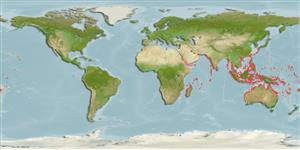>
Carangiformes (Jacks) >
Carangidae (Jacks and pompanos) > Trachinotinae
Etymology: Trachinotus: Greek, trachys, -eia, -ys = rough + Greek,noton = back (Ref. 45335).
Eponymy: Marcus Élieser Bloch (1723–1799) was a German physician and naturalist specialising in ichthyology. [...] (Ref. 128868), visit book page.
More on author: Lacepède.
Environment: milieu / climate zone / depth range / distribution range
Ecología
marino; salobre asociado a arrecife; rango de profundidad 1 - 7 m (Ref. 5439). Tropical; 31°N - 35°S, 30°E - 157°W
Indo-Pacific: Red Sea and East Africa (Ref. 3287) to the Marshall Islands and Samoa, north to southern Japan, south to Australia.
Length at first maturity / Tamaño / Peso / Age
Maturity: Lm ?, range 58 - ? cm
Max length : 110 cm FL macho / no sexado; (Ref. 1602); common length : 40.0 cm TL macho / no sexado; (Ref. 3280); peso máximo publicado: 3.4 kg (Ref. 40637)
Espinas dorsales (total) : 7; Radios blandos dorsales (total) : 18 - 20; Espinas anales: 3; Radios blandos anales: 16 - 18.
Juveniles inhabit sandy shorelines and shallow sandy or muddy bays near river mouths while adults move out in schools to clear seaward coral and rock reefs (Ref. 5213). Juveniles are in small schools, while adults are usually solitary (Ref. 48635). Adults feed primarily on sand mollusks and other hard-shelled invertebrates (Ref. 9710).
Life cycle and mating behavior
Madurez | Reproducción | Puesta | Huevos | Fecundidad | Larva
Paxton, J.R., D.F. Hoese, G.R. Allen and J.E. Hanley, 1989. Pisces. Petromyzontidae to Carangidae. Zoological Catalogue of Australia, Vol. 7. Australian Government Publishing Service, Canberra, 665 p. (Ref. 7300)
IUCN Red List Status (Ref. 130435: Version 2024-2)
Threat to humans
Reports of ciguatera poisoning (Ref. 30911)
Human uses
Pesquerías: escaso valor comercial; Acuicultura: comercial; pesca deportiva: si; Acuario: Acuarios públicos
Herramientas
Special reports
Download XML
Fuentes de Internet
Estimates based on models
Preferred temperature (Ref.
123201): 24.8 - 29.3, mean 28.4 °C (based on 3759 cells).
Phylogenetic diversity index (Ref.
82804): PD
50 = 0.5000 [Uniqueness, from 0.5 = low to 2.0 = high].
Bayesian length-weight: a=0.02630 (0.01463 - 0.04729), b=2.83 (2.68 - 2.98), in cm total length, based on LWR estimates for this species & Genus-body shape (Ref.
93245).
Nivel trófico (Ref.
69278): 3.8 ±0.36 se; based on food items.
Resiliencia (Ref.
120179): Medio, población duplicada en un tiempo mínimo de 1.4-4.4 años (Assuming tm=2-4).
Fishing Vulnerability (Ref.
59153): High to very high vulnerability (73 of 100).
Climate Vulnerability (Ref.
125649): Very high vulnerability (93 of 100).
Nutrients (Ref.
124155): Calcium = 34.7 [14.6, 65.4] mg/100g; Iron = 0.575 [0.303, 1.202] mg/100g; Protein = 19.7 [17.7, 21.7] %; Omega3 = 0.0854 [, ] g/100g; Selenium = 27.9 [14.2, 59.5] μg/100g; VitaminA = 27.7 [6.5, 105.1] μg/100g; Zinc = 0.919 [0.590, 1.375] mg/100g (wet weight); based on
nutrient studies.
